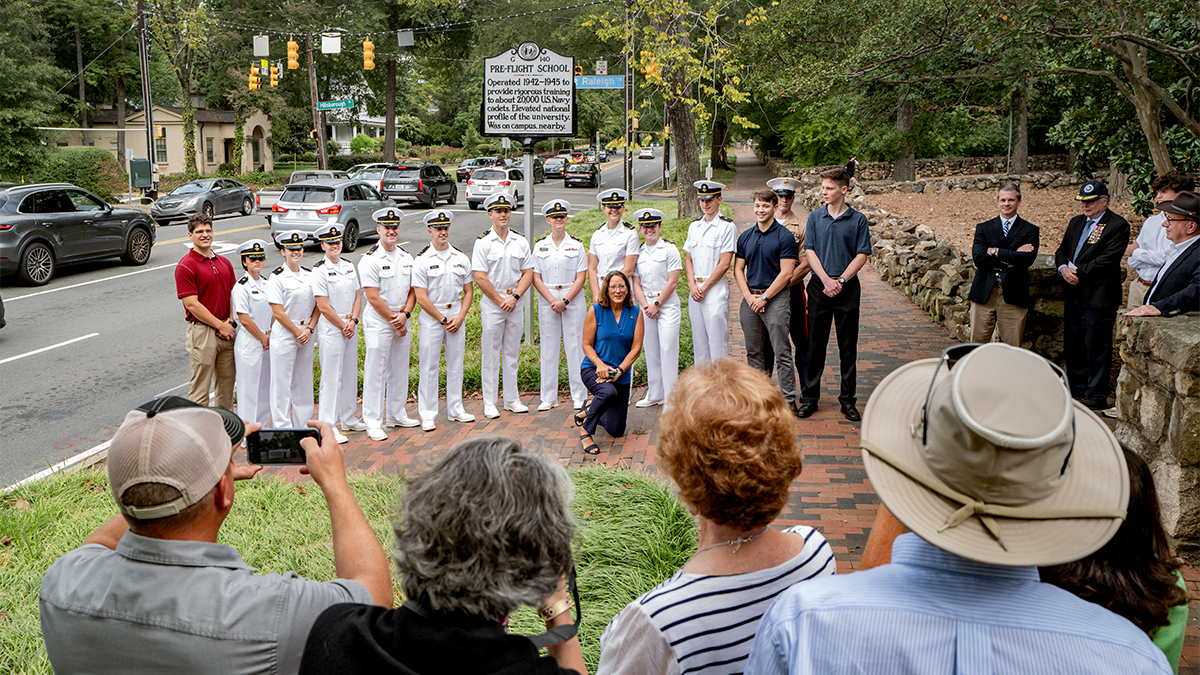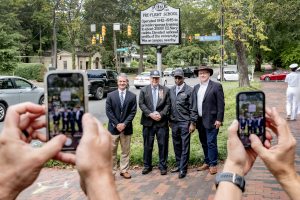New plaque honors Navy Pre-Flight School
Placed Sept. 30, the N.C. Highway Historical Marker credits the Chapel Hill school with training 20,000 WWII cadets.

Dressed in crisp white uniforms, a UNC-Chapel Hill Navy ROTC battalion gathered in front of Spencer Hall on Sept. 30 for the presentation of colors. Moments later, the great-grandchildren of a Navy cadet pulled the cover off a new historical marker.
Located near the corner of Franklin and Raleigh streets, the new N.C. Highway Historical Marker pays homage to the U.S. Navy’s Pre-Flight School, which trained nearly 20,000 cadets on Carolina’s campus from 1942 to 1945.
That training program was not only crucial for U.S. World War II efforts, but it helped elevate Carolina’s stature at a time when college enrollment was declining nationwide.
“An important thing about history is that it helps to explain why things are the way they are, and in this case, this program played an important role in the Navy’s ability to win World War II,” said retired Rear Admiral Samuel Cox, who serves as the director of Naval History and Heritage Command.
Cox was the keynote speaker at the ceremony in Chapel Hill.
“The freedom that we have today we owe to those who fought that war,” he said, “and this school played a critical part of the training of those aviators.”
The marker unveiling was an event years in the making, spearheaded by Greensboro-based real estate developer Parker Huitt. Growing up, Huitt would hear stories from his grandfather about his time training at the pre-flight school in Chapel Hill, but Huitt didn’t understand the depths of the school’s impact until he started researching it four years ago.
The training program had a transformative impact at Carolina, one of just five institutions — selected from among 70 nationwide applicants — to train naval cadets in 1942. At that time, enrollment at Carolina had slipped to roughly 2,000 students due to the war, and the town of Chapel Hill had a population of 3,500. While the pre-flight school was in operation, up to 1,875 cadets stayed on campus at the same time, undergoing rigorous training that started every morning at 5:30 and ran until 8:50 p.m.
The UNC-Chapel Hill campus was attractive to the Navy for several reasons, including its ample residential buildings, classrooms and large-scale dining hall. The program’s presence on campus was mutually beneficial, as the Navy invested resources into building dormitories, sports fields and other buildings at UNC-Chapel Hill – like Jackson Hall – that still stand.

Retired Rear Admiral Samuel Cox (second from left), who serves as the director of Naval History and Heritage Command, said the Navy Pre-Flight School “played an important role in the Navy’s ability to win World War II.” (Johnny Andrews/UNC-Chapel Hill)
Nicknamed “Little Annapolis,” the Chapel Hill pre-flight school hosted a trove of prominent cadets. Three future presidents participated in the program, with Gerald Ford serving as an instructor, George H.W. Bush serving as a cadet and then-actor Ronald Reagan providing morale-boosting entertainment. Several world-famous sports figures passed through the program, including Boston Red Sox baseball legend Ted Williams, Tar Heel football great Charlie “Choo Choo” Justice and famed Alabama football coach Paul “Bear” Bryant.
The historical marker is one way to ensure thousands of cadets and their sacrifices aren’t forgotten, and it also serves as a symbol of Carolina’s contributions during World War II and beyond.
“It was important to be here to support the history of UNC with the armed forces, especially the Navy Pre-Flight School, and to recommit and tell our veterans who want to go to school here or transition into civilian life that UNC is a great place for them,” said Provost Christopher Clemens, who spoke at the ceremony.
“We have great veterans support, and we have some really unique and signature programs. I was out here to support our entire presence as a place for veterans, which has been consistently true since that school —and before —and we’re determined to be that way in the future, too.”







